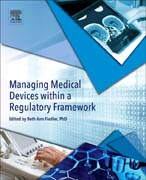
Managing Medical Devices within a Regulatory Framework helps engineers ensure proper maintenance of medical equipment for compliance and safety, anticipate problems with equipment, and utilize funding wisely for purchases. The book also advises on how to make sure that devices are compliant with HIPAA, and discusses legal issues surrounding device use and the impact of device failures on patient safety. This contributed book contains perspectives from industry professionals and academics, and provides a comprehensive look at best practices for managing healthcare technology. It will assist you with navigating worldwide regulatory frameworks for new devices and current equipment. This book provides guidance on dealing with the challenge of medical records management and compliance with patient confidentiality using information from medical devices. It also covers interoperability between and among devices outside of healthcare, and the dynamics of implementation of new devices to ensure patient safety. The authors bring forth relevant issues and challenges and demonstrate how management can foster increased clinical and non-clinical relations to enhance patient outcomes. This strategy also will enhance bottom lines by demystifying the regulatory impact on operational requirements. Covers compliance with FDA and CE regulations, plus EU directives for service and maintenance of medical devicesProvides operational and clinical practice recommendations in regard to regulatory changes for risk managementDiscusses best practices for equipment procurement and maintenanceProvides guidance on dealing with the challenge of medical records management and compliance with patient confidentiality using information from medical devices INDICE: Section 1: Health Technology Management Fundamentals 1) Reframing Product Life Cycle for Medical Devices 2) Clinical Trial Phases by Equipment Type 3) Reviewing Regulatory Guidelines by Equipment Type 4) Manufacturing/Distribution and Special Exceptions (i.e.Wellness, etc) 5) Defining medical device end life 6) What is meaningful use to the Clinical and Biomedical Engineer? Section 2: US FDA S3? Standards, Synthesis, Solutions 1) Overview and Application in Clinical Engineering 2) Roles of Biocompatibility 3) Risk Management 4) Sterility and Reusability Section 3: European Markets 1) CE and Medical Directives for the Euro Commission 2) Understanding Euro Medical Device Market: Annex X Section 4: Equipment Acquisition, Integration and maintenance 1) Evaluating new medical equipment purchases 2) Evaluating Reimbursement Strategies in the United States SIDEBAR: EU Reimbursement general information and Appendix reference to country URL's 3) Installation/Healthcare Facility Users and Maintenance Legal Responsibilities Section 5: Data Management, Patient Safety, and Efficacy 1) Clinical and Biomedical Engineering Evidence Strategy 2) Device Failure Tracking 3) Response to Manufacturing Recalls 4) Health Economics and Outcomes Research including Patient Report Outcomes (PRO) Section 6: Future of Healthcare 1) Daniel Kraft's Reimagining Healthcare for the Future of HTM 2) Challenges of New Technology: Securing Medical Devices and Their Software for HIPPA Compliance 3) Managing Smartphone and Tablet Application 4) Biomaterials in the 21st Century
- ISBN: 978-0-12-804179-6
- Editorial: Elsevier
- Encuadernacion: Rústica
- Páginas: 400
- Fecha Publicación: 01/09/2016
- Nº Volúmenes: 1
- Idioma: Inglés
